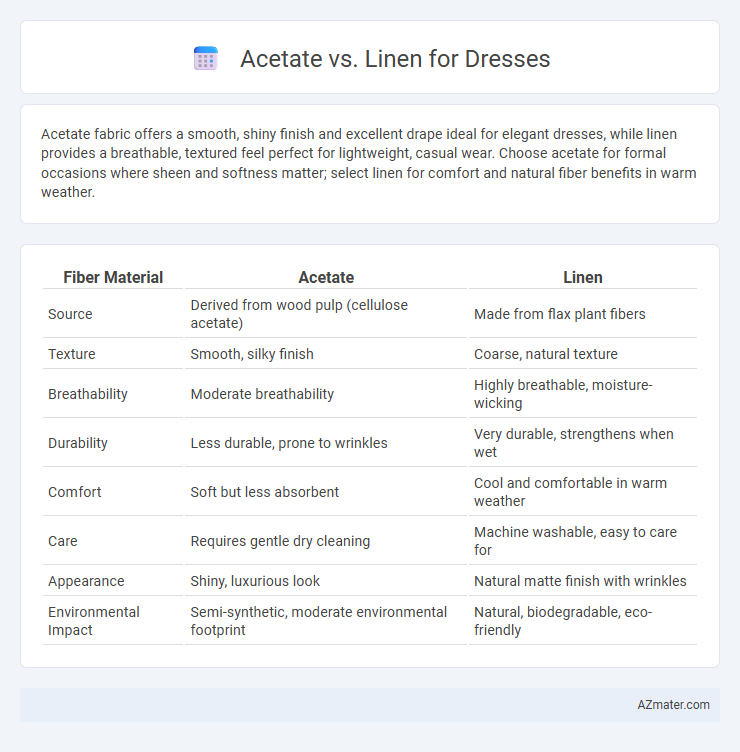Acetate fabric offers a smooth, shiny finish and excellent drape ideal for elegant dresses, while linen provides a breathable, textured feel perfect for lightweight, casual wear. Choose acetate for formal occasions where sheen and softness matter; select linen for comfort and natural fiber benefits in warm weather.
Table of Comparison
| Fiber Material | Acetate | Linen |
|---|---|---|
| Source | Derived from wood pulp (cellulose acetate) | Made from flax plant fibers |
| Texture | Smooth, silky finish | Coarse, natural texture |
| Breathability | Moderate breathability | Highly breathable, moisture-wicking |
| Durability | Less durable, prone to wrinkles | Very durable, strengthens when wet |
| Comfort | Soft but less absorbent | Cool and comfortable in warm weather |
| Care | Requires gentle dry cleaning | Machine washable, easy to care for |
| Appearance | Shiny, luxurious look | Natural matte finish with wrinkles |
| Environmental Impact | Semi-synthetic, moderate environmental footprint | Natural, biodegradable, eco-friendly |
Introduction to Fabric Choices: Acetate vs Linen
Acetate offers a smooth, silky texture with excellent drape, making it ideal for elegant dresses that require a lustrous finish and lightweight feel. Linen provides a natural, breathable fabric with exceptional moisture-wicking properties, perfect for casual or summer dresses demanding comfort and durability. Choosing between acetate and linen depends on the desired aesthetic, climate, and dress functionality.
What is Acetate? Key Features and Benefits
Acetate is a semi-synthetic fiber made from cellulose derived from wood pulp, known for its luxurious silk-like appearance and smooth texture. It offers excellent drape, vibrant color retention, and moisture absorbency, making it ideal for elegant dresses that require fluidity and comfort. The fabric's breathable nature combined with its resistance to shrinking and wrinkling enhances garment longevity and wearer comfort.
Exploring Linen: Natural Properties and Advantages
Linen, derived from the flax plant, boasts exceptional breathability and moisture-wicking properties, making it ideal for warm-weather dresses. Its natural durability and resistance to pilling outperform acetate, which tends to be less breathable and prone to static cling. Linen's biodegradable nature and hypoallergenic qualities add to its appeal as an eco-friendly, comfortable fabric choice.
Texture and Appearance: Acetate vs Linen
Acetate fabrics showcase a smooth, silky texture with a subtle sheen that lends dresses a luxurious and elegant appearance, making them ideal for formal wear. In contrast, linen features a coarser, natural texture with visible fibers and a matte finish, providing a casual, breathable, and rustic look perfect for summer dresses. The texture of acetate contributes to a polished drape, while linen's texture creates a relaxed silhouette with natural wrinkles that enhance its organic charm.
Breathability and Comfort Comparison
Acetate and linen differ significantly in breathability and comfort, with linen offering superior airflow due to its natural fiber structure that allows moisture to evaporate quickly, keeping the wearer cool. Acetate, being a semi-synthetic fabric derived from cellulose, tends to trap heat and moisture, making it less breathable and comfortable in warm conditions. Linen's lightweight, hypoallergenic properties enhance comfort for prolonged wear, whereas acetate may feel smoother but lacks the same moisture-wicking efficiency.
Durability and Longevity: Which Fabric Lasts Longer?
Acetate fabric offers a smooth, silky feel but tends to be less durable and prone to damage from heat and moisture, which can reduce its longevity when used in dresses. Linen, known for its strong natural fibers, exhibits high durability and improves in softness over time with proper care, making it a longer-lasting choice. Choosing linen for dresses ensures extended wear and resistance to wear and tear compared to acetate.
Care and Maintenance: Acetate vs Linen Dresses
Acetate dresses require gentle hand washing or dry cleaning to maintain their smooth texture and prevent shrinking, with low heat ironing recommended to avoid damage. Linen dresses, known for their breathability and durability, can be machine washed on a gentle cycle but must be air-dried to prevent excessive wrinkling and fabric weakening. Both fabrics benefit from proper storage to retain shape, but acetate demands more delicate handling due to its synthetic nature compared to the natural fiber strength of linen.
Environmental Impact of Acetate and Linen
Acetate, derived from cellulose but processed with chemical solvents, poses environmental concerns due to energy-intensive production and potential chemical pollutants. Linen, made from flax plants, offers a more sustainable option with lower water use, biodegradable fibers, and minimal pesticide requirements. Choosing linen dresses significantly reduces ecological footprint through renewable crop sourcing and less harmful manufacturing processes.
Best Occasions for Wearing Acetate or Linen Dresses
Acetate dresses are ideal for formal occasions such as weddings and evening events due to their silky sheen and smooth drape, offering a polished and elegant appearance. Linen dresses suit casual and daytime settings like garden parties, beach outings, or summer brunches, providing breathability and a relaxed yet stylish look. For warm weather, linen's moisture-wicking properties make it the preferred choice, whereas acetate's wrinkle-resistant fabric is better suited for structured, sophisticated events.
Final Verdict: Choosing Between Acetate and Linen for Your Next Dress
Acetate dresses offer a smooth, glossy finish and excellent drape, making them ideal for elegant, formal wear while providing good moisture absorption. Linen dresses excel in breathability, durability, and natural texture, perfect for casual, warm-weather outfits despite their tendency to wrinkle easily. Choosing between acetate and linen depends on desired dress style, comfort needs, and occasion, with acetate suited for polished looks and linen preferred for relaxed, breathable wear.

Infographic: Acetate vs Linen for Dress
 azmater.com
azmater.com